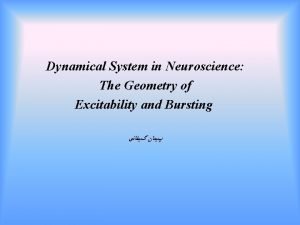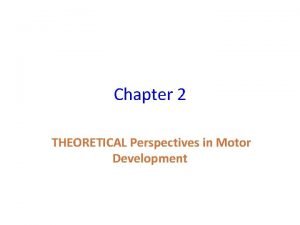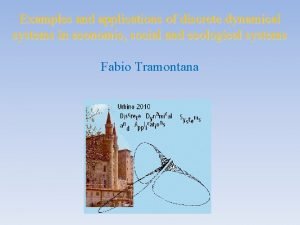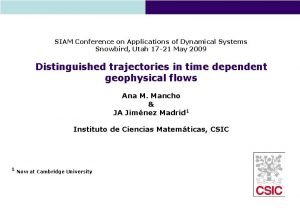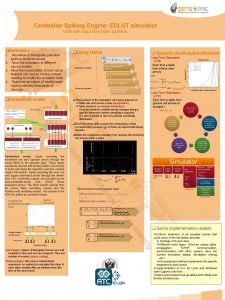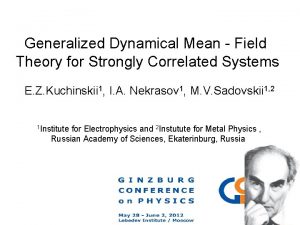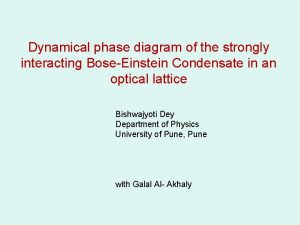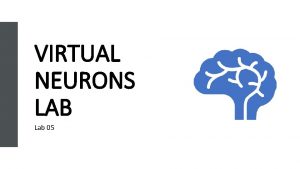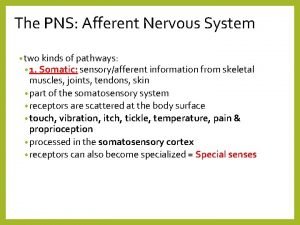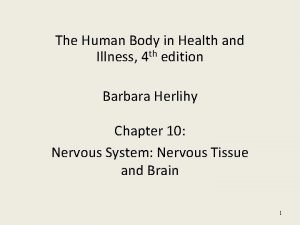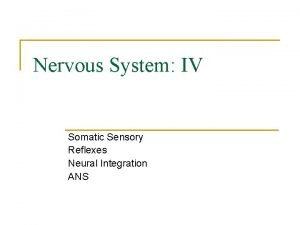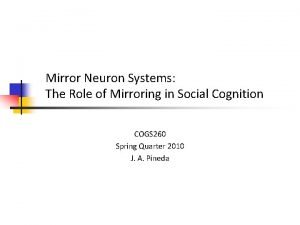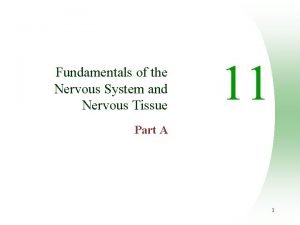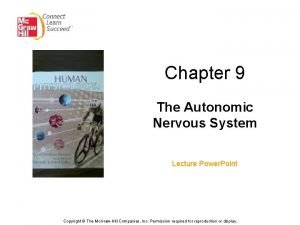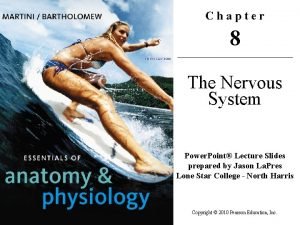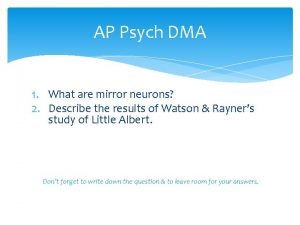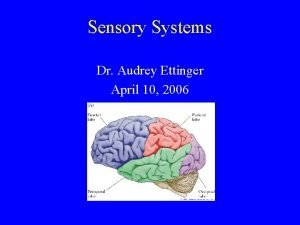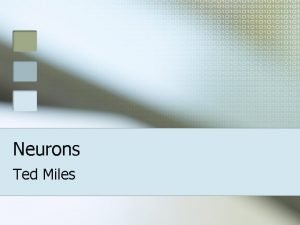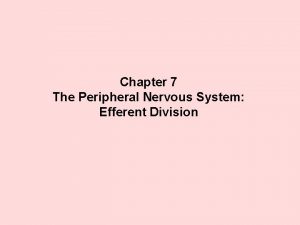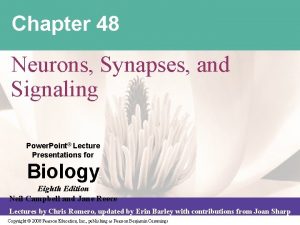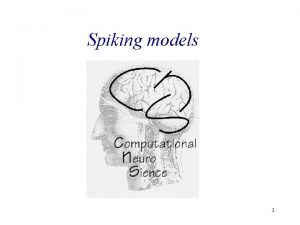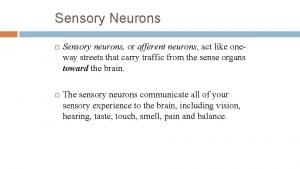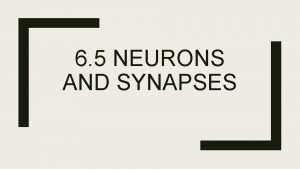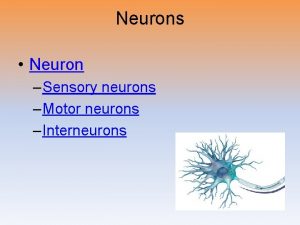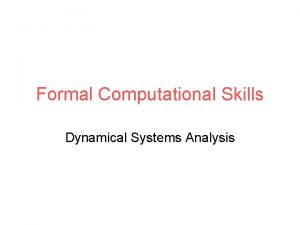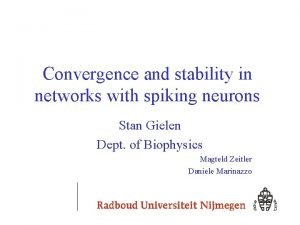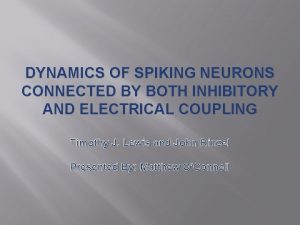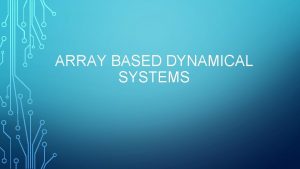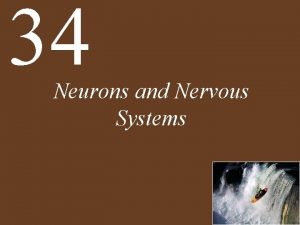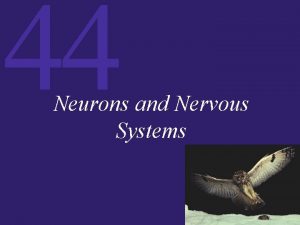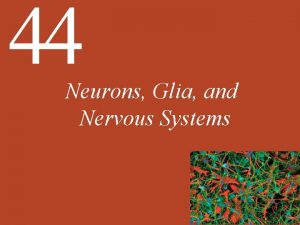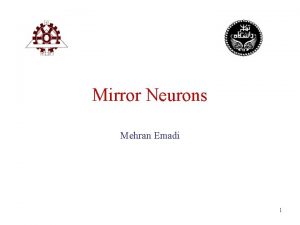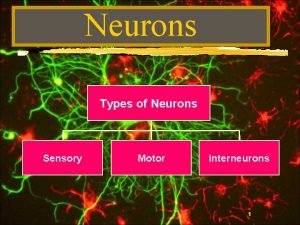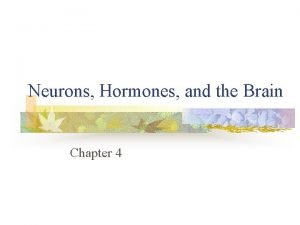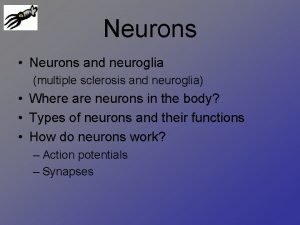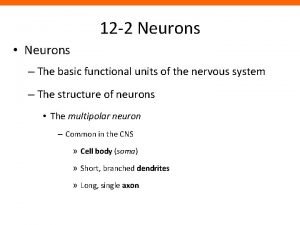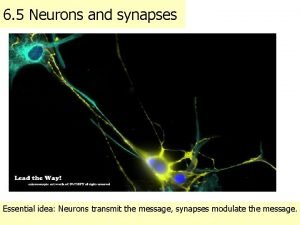Dynamical Systems Analysis for Systems of Spiking Neurons


































- Slides: 34

Dynamical Systems Analysis for Systems of Spiking Neurons

Models: Leaky Integrate and Fire Model Cd. V/dt= -V/R+Isyn • Resting Potential VRest assumed to be 0. • CR = Membrane time constant (20 msec for excitatory neurons, 10 msec for inhibitory neurons. ) • Spike generated when V reaches VThreshold • Voltage reset to VReset after spike (not the same as VRest) • Synaptic Current Isyn assumed to be either delta function or alpha function.

Models: Spike-Response Model Observation: The L-IF-model is linear Cd. V 1/dt= -V 1/R+I 1 syn Cd. V 2/dt= -V 2/R+I 2 syn Cd(V 1+V 2)/dt= -(V 1+V 2)/R+I 1 syn+I 2 syn Why not simply take the individual effect of each spike and add them all up? Result: The Spike response model. V(t)=effect of previously generated spikes by neuron+ sum over all effects generated by spikes that have arrived at synapses

Background: The Cortical Neuron • Synapse • Dendrites (Input) • Cell Body • Axon (Output) Output Input Threshold • Absolute Refractory Period • Exponential Decay of effect of a spike on membrane potential Time

Background: Target System Neocortical Column: ~ 1 mm 2 of the cortex Output Recurrent network ~100, 000 neurons ~10, 000 synapses per neuron ~80% excitatory ~20% inhibitory Recurrent System Input

Background: The Neocortex (Healthy adult human male subject) Source: Dr. Krishna Nayak, SCRI, FSU

Background: The Neocortex (Area V 1 of Macaque Monkey) Source: Dr. Wyeth Bair, CNS, NYU

Background: Dynamical Systems Analysis Phase Space • Set of all legal states Dynamics • Velocity Field • Flows • Mapping Local & Global properties • Sensitivity to initial conditions • Fixed points and periodic orbits

Content: • Model • A neuron • System of Neurons: Phase Space & Velocity Field • Simulation Experiments • Neocortical Column • Qualitative Characteristics: EEG power spectrum & ISI frequency distribution • Formal Analysis • Local Analysis: Sensitivity to Initial Conditions • Conclusions

Model: Single Neuron t=0 t=0 Potential Function Each spike represented as: How long since it departed from soma. Time

Model: Single Neuron: Potential function

Model: System of Neurons • Dynamics • Birth of a spike • Death of a spike • Point in the Phase-Space • Configuration of spikes

Model: Single Neuron: Phase-Space

Model: Single Neuron: Phase-Space Theorem: Theorem Phase-Space can be defined formally Phase-Space for Total Number of Spikes Assigned = 1, 2, & 3.

Model: Single Neuron: Structure of Phase-Space • Phase-Space for n=3 • 1, 2 dead spikes.

Model: System of Neurons: Velocity Field

Simulations: Neocortical Column: Setup • 1000 neurons each connected randomly to 100 neurons. • 80% randomly chosen to be excitatory, rest inhibitory. • Basic Spike-response model. • Total number of active spikes in the system ►EEG / LFP recordings • Spike Activity of randomly chosen neurons ►Real spike train recordings • 5 models: Successively enhanced physiological accuracy • Simplest model • Identical EPSPs and IPSPs, IPSP 6 times stronger • Most complex model • Synapses: Excitatory (50% AMPA, NMDA), Inhibitory (50% GABAA, GABAB) • Realistic distribution of synapses on soma and dendrites • Synaptic response as reported in (Bernander Douglas & Koch 1992)

Simulations: Neocortical Column: Classes of Activity Number of active spikes: spikes Seizure-like & Normal Operational Conditions

Simulations: Neocortical Column: Chaotic Activity T=0 T=1000 msec Normal Operational Conditions (20 Hz): Hz) Subset (200 neurons) of 1000 neurons for 1 second.

Simulations: Neocortical Column: Total Activity Normalized time series: series Total number of active spikes & Power Spectrum

Simulations: Neocortical Column: Spike Trains Representative spike trains: trains Inter-spike Intervals & Frequency Distributions

Simulations: Neocortical Column: Propensity for Chaos ISI’s of representative neurons: neurons 3 systems; 70%, 80%, 90% synapses driven by pacemaker

Simulations: Neocortical Column: Sensitive Dependence on Initial Conditions T=0 T=400 msec Spike activity of 2 Systems: Systems Identical Systems, subset (200) of 1000 neurons, Identical Initial State except for 1 spike perturbed by 1 msec.

Analysis: Local Analysis • Are trajectories sensitive to initial conditions? conditions • If there are fixed points or periodic orbits, orbits are they stable? stable

Analysis: Setup: Riemannian Metric

Analysis: Setup: Riemannian Metric • Discrete Dynamical System • Event ►Event…. • Event: birth/death of spike

Analysis: Measure Analysis Death of a Spike PI Birth of a Spike

Analysis: Perturbation Analysis

Analysis: Perturbation Analysis

Analysis: Local Cross-Section Analysis AT B Birth C Death If then sensitive to initial conditions. If then insensitive to initial conditions.

Analysis: Local Cross-Section Analysis

Analysis: Local Cross-Section Analysis: Prediction

Analysis: Local Cross-Section Analysis: Prediction Seizure Normal Spike rate >1 =1 <1 Neocortical Column =1

Analysis: Discussion • Existence of time average • Systems without Input and with Stationary Input Transformation invariant (Stationary) Stationary Probability measure exists. System has Ergodic properties. • Systems with Transient Inputs ? • Information Coding (Computational State vs. Physical State) • Attractor-equivalent of class of trajectories.
 Dynamical systems neuroscience
Dynamical systems neuroscience Dynamical systems theory motor development
Dynamical systems theory motor development Accelarationist
Accelarationist Dynamical systems examples
Dynamical systems examples Siam conference on applications of dynamical systems
Siam conference on applications of dynamical systems Tonic spiking
Tonic spiking What is spiking in ruby laser?
What is spiking in ruby laser? Spiking neural network tutorial
Spiking neural network tutorial Repeat
Repeat Dynamical mean-field theory
Dynamical mean-field theory Dynamical
Dynamical Virtual neurons
Virtual neurons Type 1 cutaneous mechanoreceptors
Type 1 cutaneous mechanoreceptors Homunculus
Homunculus Via optica
Via optica Temporal summation vs spatial summation
Temporal summation vs spatial summation Input neurons
Input neurons Alpha and gamma motor neurons
Alpha and gamma motor neurons Stretch reflex example
Stretch reflex example Proprioception autism
Proprioception autism Mirror neuron
Mirror neuron Input neurons
Input neurons Identify each type of neuronal pool
Identify each type of neuronal pool Corticospinal tract
Corticospinal tract Fourth order neurons
Fourth order neurons Fourth order neurons
Fourth order neurons Preganglionic parasympathetic fibres
Preganglionic parasympathetic fibres Figure 8-2 neurons and neuroglia
Figure 8-2 neurons and neuroglia Mirror neurons ap psych
Mirror neurons ap psych Audrey ettinger
Audrey ettinger What are neurons composed of
What are neurons composed of Neuroglial cell
Neuroglial cell Efferent motor neurons
Efferent motor neurons Chapter 48 neurons synapses and signaling
Chapter 48 neurons synapses and signaling Unipolar neurons are found in
Unipolar neurons are found in
